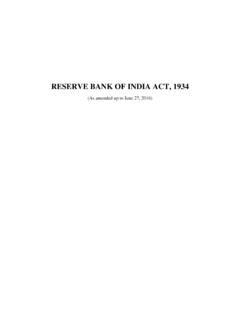Transcription of WATER RIGHTS IN OREGON
1 O r e g o n W a t e r R e s o u r c e s D e p a r t m e n t C e n t e n n i a l E d i t i o n S e p t e m b e r 2 0 0 9 WATER RIGHTS IN OREGON An Introduction to OREGON s WATER Laws 2018 WATER measurements are generally described using rate and volume. When applying for a permit to use WATER , an applicant is required to submit all measurements in one of the following terms. When referring to a rate to be diverted, the terms commonly used are cubic feet per second (cfs) or gallons per minute (gpm). When discussing volumes of WATER (duty), such as amount applied to land, reservoir storage capacity, or yearly consumption, the term used is acre-feet (af). Applications for WATER use specify the appropriate measurement to use when providing information to the Department.
2 Rates of Flow One (1) cubic foot per second (cfs) is a rate of WATER flow that will supply one cubic foot of WATER in one second and is equivalent to flow rates of: gallons per second gallons per minute 646,272 gallons per day acre-feet per day Volume Measurement One (1) acre-foot is the volume of WATER that will cover one acre to a depth of one foot and is equal to: 43,560 cubic feet 325,851 gallons WATER Quantity Conversion Table Land Subdivision 6 5 4 3 2 1 7 8 9 10 11 12 18 17 16 15 14 13 19 20 21 22 23 24 30 29 28 27 26 25 31 32 33 34 35 36 - - - - -Township 6 miles- - - - - NW NW NE NW NW NE NE NE SW NW SE NW SW NE SE NE NW SW NE SW NW SE NE SE SW SW SE SW SW SE SE SE 160 acres 10 80 acres 20 40 acres 320 acres Section 1 Mile 640 acres 1 af = 1 cfs = - - - - -Range 6 miles- - - - - CONTENTS THE WATER RESOURCES COMMISSION AND 3 To serve the public by practicing and promoting responsible WATER management.
3 1. OREGON WATER 5 WATER management in OREGON 2. WATER PROTECTIONS AND 11 managing WATER appropriations; protecting the resource 3. OBTAINING NEW WATER 15 gaining authorization to use WATER 4. OTHER WATER 25 authorization for WATER use 5. TRANSFERRING WATER 29 changes to existing RIGHTS 6. CANCELLING WATER 35 loss of WATER RIGHTS through non-use 7. 36 encouraging efficient WATER use 8. FINDING WATER 39 determining if you have a WATER right and updating contact information for a WATER right 9. WATER DISTRIBUTION AND 40 watermasters and field staff protect RIGHTS and resources 10. REGION OFFICES AND WATERMASTER 42 11. 45 APPENDIX 46 other development permits APPENDIX 48 dam safety in OREGON WATER RIGHTS IN OREGON 1 2 WATER RIGHTS IN OREGON THE WATER RESOURCES COMMISSION AND DEPARTMENT To serve the public by practicing and promoting responsible WATER management through two key goals: to directly address OREGON 's WATER supply needs, and to restore and protect streamflows and watersheds in order to ensure the long-term sustainability of OREGON 's ecosystems, economy, and quality of life.
4 The WATER Resources Commission is a seven-member citizen body established by statute to set WATER policy for the state and oversee activities of the WATER Resources Department in accordance with state law. Members are appointed by the Governor, subject to confirmation by the OREGON Senate, to serve a four-year term. One member is appointed from each of five regional river basin management areas, and two at large members are appointed, one each from east and west of the Cascades. In 2017, the OREGON WATER Resources Commission updated the state's Integrated WATER Resources Strategy (Strategy), which contains recommendations to help understand and meet the state's instream and out-of-stream WATER needs into the future.
5 Developed with the state's other natural resources and economic development agencies, the Strategy serves as a roadmap for addressing WATER quantity, WATER quality, and ecosystem issues. The Strategy is updated every five years. The WATER Resources Department is the state agency charged with administration of the laws governing the allocation of surface WATER and groundwater resources. The Department is organized into five divisions - Field Services, Technical Services, WATER Right Services, Administrative Services, and the Director s Office - all operating under the immediate authority of the Director. The Director is appointed by the Governor to serve a four-year term, subject to confirmation by the OREGON Senate.
6 The Director is charged with applying the Commission s policies and rules through Department programs. In addition, the Director has independent responsibility for general stream adjudications. WATER RIGHTS IN OREGON 3 4 WATER RIGHTS IN OREGON 1. OREGON WATER LAWS WATER management in OREGON The WATER Code Under OREGON law, all WATER belongs to the public. With some exceptions, cities, irrigators, businesses, and other WATER users must obtain a permit or license from the WATER Resources Department to use WATER from any source - whether it is underground, or from lakes or streams. Generally speaking, landowners with WATER flowing past, through, or under their property do not automatically have the right to use that WATER without authorization from the Department.
7 Prior Appropriation OREGON s WATER laws are based on the doctrine of prior appropriation. This means the first person to obtain a WATER right on a stream is the last to be shut off in times of low streamflows. In WATER -short times, the WATER right holder with the oldest date of priority can demand the WATER specified in his or her WATER right without regard for the needs of junior users. If there is a surplus beyond what is necessary to fulfill the senior right, the WATER right holder with the next senior priority date can take what is available to satisfy needs under his or her right. This continues down the line until there is no surplus or until all RIGHTS are satisfied. The date of application for a permit to use WATER usually becomes the priority date of the right.
8 East of the Mississippi River, the riparian doctrine usually applies. Under the riparian doctrine, only landowners with WATER flowing through their property have claims to the WATER . By contrast, the prior appropriation doctrine is the basis of WATER law for most of the states west of the Mississippi. In OREGON , the prior appropriation doctrine was adopted into statute on February 24, 1909 and introduced state control over the right to use WATER . Before then, WATER users had to depend on themselves or local courts to defend their RIGHTS to WATER . WATER RIGHTS IN OREGON 5 For more information, refer to ORS With some exceptions, a WATER right, permit, or license is required to use the waters of OREGON .
9 The WATER must be used for a beneficial purpose, without waste. OREGON S WATER CODE four fundamental provisions Beneficial purpose without waste Surface or groundwater may be legally diverted for use only if it is used for a beneficial purpose without waste. Priority The WATER right priority date determines who gets WATER in a time of shortage. The more senior the WATER right, the longer WATER may be available in a time of shortage. Appurtenancy Generally, a WATER right is attached to the land described in the right, as long as the WATER is used. If the land is sold, the WATER right typically goes with the land to the new owner. Must be used Once established, a WATER right must be used as provided in the right at least once every five years.
10 With some exceptions established in law, after five consecutive years of non-use, the right is considered forfeited and is subject to cancellation. Generally, OREGON law does not provide a preference for one kind of use over another. If there is a conflict between users, the date of priority determines who may use the available WATER . If the RIGHTS in conflict have the same date of priority, then the law indicates domestic use and livestock watering have preference over other uses. However, if a drought is declared by the Governor, the Commission can adopt rules that give preference to stock watering and human consumptive purposes, regardless of the priority dates. 6 WATER RIGHTS IN OREGON WATER RIGHTS IN OREGON 7 Junior User 1970 WATER Right This WATER right is regulated back to meet the downstream need of the senior WATER right.














